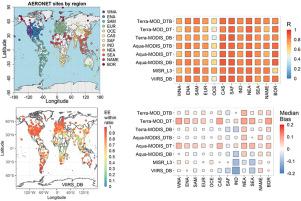Atmospheric Research ( IF 4.5 ) Pub Date : 2021-08-14 , DOI: 10.1016/j.atmosres.2021.105810 Qi-Xiang Chen 1, 2 , Xin-Lei Han 2, 3, 4 , Yu Gu 2 , Yuan Yuan 1 , Jonathan H. Jiang 5 , Xue-Bo Yang 6 , Kuo-Nan Liou 2 , He-Ping Tan 1

|
This study presents a comprehensive evaluation of eight aerosol optical depth (AOD) products from the latest MODIS C6.1 DT, DB and DTB, MISR V23, and VIIRS V1 DB dataset against the Aerosol Robotic Network (AERONET) measurements on global scale during 2012 to 2019. The latest MODIS DB products are found to be superior over DT in most cases. MODIS DTB products generally have a better performance than either DT or DB. VIIRS shows the best overall performance on global and regional scale while MISR has a systematic underestimation in moderate and high AOD conditions. Median AOD bias shows distinct regional dependence with the biggest divergence between satellite AOD products appearing in Asia. All these AOD products tend to have better performance in high latitude region and poorer performance in the tropics likely due to the complex aerosol condition and common high cloud cover in the tropics. Time series stability evaluation shows a distinct temporal pattern of statistics, in which the observation number and median AOD bias tend to be high in summer while low in winter and correlation R has a reversing trend. Among these products, VIIRS V1 DB has the highest time series stability of bias. Influence of aerosol loading, particle size, land use, elevation, and precipitable water and temperature on AOD retrievals is broadly consistent between products. High aerosol loading, small particle size, bright surface, high altitude, and high precipitable water and temperature tend to decrease the retrieval accuracy, e.g. lower expected error (EE) within ratio and larger median bias. The latest AOD products need to be furthermore improved under extreme conditions like very fine aerosols, elevated terrain and high precipitable water and temperature.
中文翻译:

陆地上 MODIS、MISR 和 VIIRS 每日 3 级气溶胶光学深度产品的评估
本研究针对 2012 年全球范围内的气溶胶机器人网络 (AERONET) 测量,对来自最新 MODIS C6.1 DT、DB 和 DTB、MISR V23 和 VIIRS V1 DB 数据集的八种气溶胶光学深度 (AOD) 产品进行了综合评估到 2019 年。在大多数情况下,发现最新的 MODIS DB 产品优于 DT。MODIS DTB 产品通常比 DT 或 DB 具有更好的性能。VIIRS 在全球和区域范围内表现出最佳的整体性能,而 MISR 在中等和高 AOD 条件下有系统的低估。中值 AOD 偏差显示出明显的区域依赖性,亚洲出现的卫星 AOD 产品之间的差异最大。所有这些 AOD 产品在高纬度地区往往性能较好,而在热带地区性能较差,这可能是由于热带地区气溶胶条件复杂和普遍的高云层覆盖所致。时间序列稳定性评价显示出明显的统计时间规律,观测次数和AOD中值偏差在夏季趋于高,冬季趋于低,相关性R有逆转趋势。在这些产品中,VIIRS V1 DB 的偏差时间序列稳定性最高。气溶胶载荷、颗粒大小、土地利用、海拔、可降水水和温度对 AOD 反演的影响在产品之间大体一致。高气溶胶负载、小粒径、光亮表面、高海拔、高可降水水和高温度往往会降低反演精度,例如 比率内较低的预期误差 (EE) 和较大的中值偏差。最新的 AOD 产品需要在极端条件下进一步改进,例如极细的气溶胶、高地和高可降水量和温度。











































 京公网安备 11010802027423号
京公网安备 11010802027423号